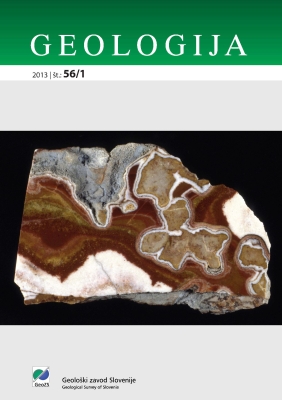Opuščeni rudnik Remšnik z ramsbeckitom in namuwitom(?)
DOI:
https://doi.org/10.5474/geologija.2013.005Povzetek
Polimetalno rudišče Remšnik se nahaja na Kobanskem v severni Sloveniji. Mineralizacija nastopa v narivni coni med staropaleozojskimi nizkometamorfnimi kamninami Štalenskogorske formacije, Remšniškega pokrova in retrogradno metamorfnih skrilavcev Avstroalpinske podlage. Hidrotermalno orudenje in okremenitev sledita skrilavemu klivažu v delno brečiranih lečah dolomitnih marmorjev ter podrejeno metatufitov in filitov. Najverjetneje je nastalo v povezavi z živahnim terciarnim magmatizmom, ki je ugotovljen in razkrit na območju današnjega Pohorja. Mineralno paragenezo prevladujočega Pb, Cu, Zn srebronosnega sulfidnega orudenja spremlja pestra združba sekundarnih mineralov. Med njimi se nahajata pri nas prvič opisana redka vodna sulfata bakra in cinka. Zelene, prosojne monoklinske kristale, velikosti le nekaj desetink milimetra, smo z vrstičnim elektronskim mikroskopom določili kot ramsbeckit (Cu, Zn)15(SO4)4(OH)22 ∙ 6(H2O). Zelenkaste barve so tudi lističasti, po obliki heksagonalni, cvetasti kristalni zraščenci, ki najverjetneje pripadajo namuwitu (Cu, Zn)4(SO4)(OH)6 ∙ 4(H2O). Zaradi submikroskopske velikosti in majhne količine njegova določitev še ni zanesljiva.Prenosi
Kako citirati
Trajanova, M., & Žorž, Z. (2013). Opuščeni rudnik Remšnik z ramsbeckitom in namuwitom(?). Geologija, 56(1), 57–71. https://doi.org/10.5474/geologija.2013.005
Številka
Rubrika
Članki

